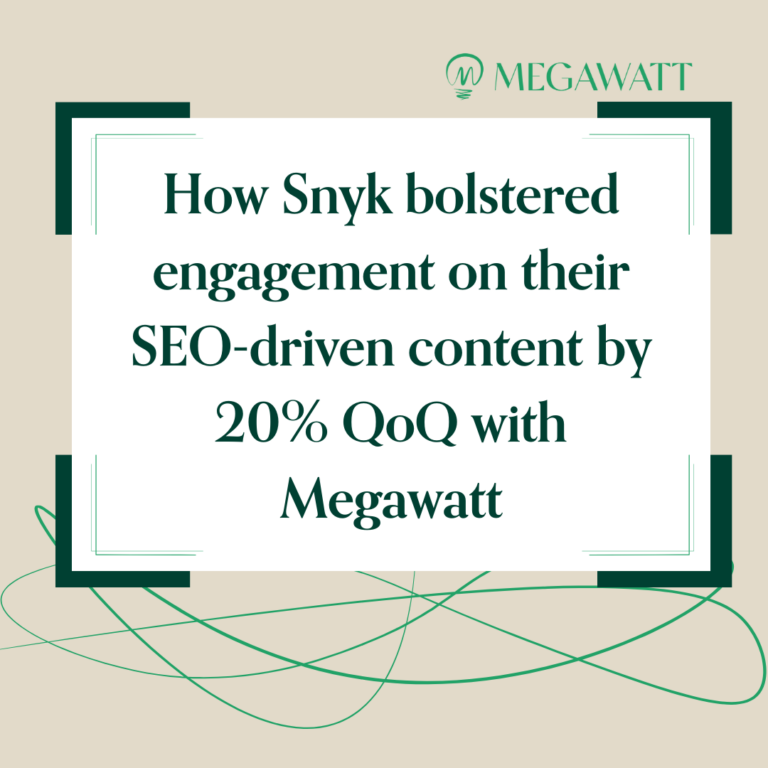A Content Audit Checklist for B2B Marketing
Most marketers probably consider content audits a standard tool in their content marketing toolbelt. However, content audits can be deceptive.
When done right, a good content audit can provide a powerful combination of tactical and strategic insights. What’s more often the case, however, is that easy access to myriad metrics, pressure from the C-suite, and marketing teams strapped for time cause content audits to spiral out of control (not to mention scope!) — if they get off the ground at all.
The good news is that content audits don’t have to be painful, and they don’t have to spiral into projects that put a drain on your department’s time, money, and sanity. The key is to simplify your process.
But what does that actually look like? We’ve compiled a content audit checklist to help you plan, execute on, and strategize from your next content audit.
Are content audits worth it?
Before we dive into the details of our content audit checklist, let’s take a moment to remind ourselves why content audits are useful in the first place. Put simply, content audits can help us identify what’s working, what’s not working, and what can be improved.
As noted before, content audits can pack a one-two punch by offering tactical and strategic insights. This can look like asset-level recommendations (e.g. This blog is not performing. It needs a refresh.) or higher-level, strategic recommendations (e.g. We need more engagement- and conversion-minded content to guide leads closer to conversion). Sometimes, content audits surprise us with insights about our content strategy that might not feel intuitive or that might spin our thinking in a whole new direction.
In summary, content audits can give us more informed direction on where to focus our efforts to meet our overall marketing and business goals better.
A nice side benefit is that content audits are also a great tool to have in your back pocket when discussing your content strategy with others – especially non-marketing executives less familiar with the day-to-day operations of most marketing programs. Think of the findings of your content audit as the “proof points” you bring to any discussion on why your strategy looks the way it does.
Sign up for Dear Wattson, our weekly newsletter, where all content conundrums are answered!
How to build and execute a content audit: A checklist
Just like finding an all-you-can-eat buffet filled with your favorite foods, it can be easy to overindulge and let your content audit spin out of control. Here are the key steps to remember when executing your content audit to help you maintain focus.
Set a clear, specific content audit goal
A quick search online will show you that there are several types of content audits and nearly a dozen ways to run each. That’s why your first step to conducting a successful audit is to get very clear about your content audit goals.
To do so, start with why you’re considering conducting a content audit in the first place: What challenges are you facing? For example, are you struggling to rank for a specific SEO keyword? Or maybe you’re unsure which content topics resonate with (or bore) your target audience. Maybe you’re new to the marketing team and simply don’t know what content is out there.
Next, translate that challenge into a specific goal: What do you want this audit to achieve? For example, if your challenge is that you’re not ranking for a specific SEO keyword, maybe your content audit goal could be to identify which keywords you are ranking for, those you have the potential to rank for, and those you would have to do a lot of work to rank for. Content audits pack the most punch when used to answer a specific challenge, rather than being tasked with solving all your content marketing problems, so do your best to keep your audit focused.
Collect all relevant data (but nothing else!)
Your next task is to collect all the data necessary for your audit. But before you start crawling your website and exporting spreadsheets, you must put guardrails around the data you plan to collect. This is critical, as this step is where many audits veer off the tracks.
At Megawatt, we encourage our clients only to collect the data that will help them reach their specific content audit goal. For example, suppose you’re conducting an audit to determine which content topics your audience engages with the most. In that case, you should measure performance and engagement metrics, such as page views, average session duration, and exit rate – but you probably don’t need to look at SEO keyword performance for this audit.
In addition to baseline information you should collect on all audits (URL, asset title, publish date, etc.), we recommend keeping your list of metrics-to-measure to a limited number. Remember: Simplify and focus.
Once you know what types of data to collect, add another layer of guardrails by asking:
- What: What assets are we auditing? All blogs? Sale enablement assets? Website pages?
- When: What timeframe should we look at? Content from the past quarter? All time?
- Who: Who will execute each step of the audit?
- How: How long will this take, realistically? What platforms, such as Google Analytics, do we need to perform this audit?
Document all this information in one spot and, most importantly, don’t deviate from it!
From here, you’re all set to begin pulling data. There are several spreadsheets of varying levels of sophistication online where you can house your data. You can also get in touch with our team for advice on how to format and organize your audit data.
Assess and analyze your data
Your next step? It’s time to fire up those brain cells and make sense of all the data you collected. Again, it’s best to start simple. First, work with your team to create indicators for what you would consider good content, mediocre content, and low-performing content. Industry benchmarks are a great place to start when determining what a “high-performing” asset looks like for your company.
Here’s an example of how we identify and classify high-performing content, mediocre content, and low-performing content at Megawatt when conducting an audit looking at content performance and audience engagement.
| Performance Classification | Description | Indicators |
| Full wattage! | Top performing content | High traffic + high engagement |
| Flickering light | Middling content with the potential for better performance | High traffic + low engagement Low traffic + high engagement |
| Burnt bulb | The worst performing content | Low traffic + low engagement |
After you’ve gone through and painted broad strokes on each asset’s performance, get a little more granular. Remember as you go through that you have more options than “publish more” and “delete content.” For example, if you have a high-performing asset, can you repurpose it? If you have a mediocre asset, can you update or refresh it to turn it into a high-performing asset? Can your low performers be saved with a refresh? Or, really, should they be pruned? Document a recommendation for each asset.
***
You might also like:
SEO Copywriting Checklist: Write For Humans & Optimize For Search
***
Create a plan of action
While it can feel tedious to rank and determine the next steps for each and every asset, it opens the door for you to identify both immediate and more long-term strategic actions to improve your content library and performance.
For example, there’s no point in keeping your low-performing assets if they cannot be saved – so delete them. Have a bunch of middling blogs with the potential for greatness? Focus your efforts over the next several weeks on blog refreshes and repurposes.
It’s also important to see the forest through the trees. Look at your content from a wider lens and ask yourself: Are there any big trends or commonalities? Is there any data that surprises you? Most importantly, how do the findings of your content audit inform the original content audit goal you set out with? Take the answers to these questions to your next strategy session.
Think it’s time to take the content audit plunge?
Content audits should not be underestimated. They take a fair amount of work and critical thinking — but if kept within scope, they can be a powerful tool in making more informed decisions around your content strategy.
At Megawatt, we encourage clients to conduct a content audit at the beginning of a new engagement or year, if their content feels stale, if their strategy needs a shakeup, or if they simply want to track the impact of their content strategy. If any of these sound like you, let us know! We’re happy to work with you to determine how a content audit can move your content strategy forward.
Need help strategizing your next content audit?
Contact us today.






